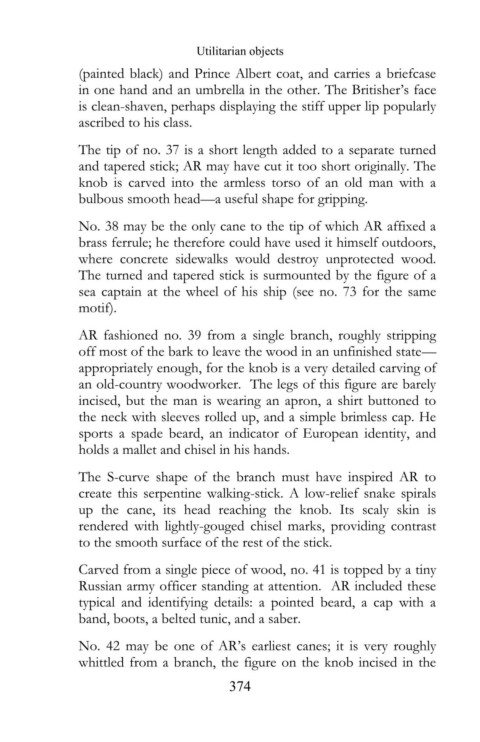Page 378 - The Legacy of Abraham Rothstein - text
P. 378
Utilitarian objects
(painted black) and Prince Albert coat, and carries a briefcase
in one hand and an umbrella in the other. The Britisher’s face
is clean-shaven, perhaps displaying the stiff upper lip popularly
ascribed to his class.
The tip of no. 37 is a short length added to a separate turned
and tapered stick; AR may have cut it too short originally. The
knob is carved into the armless torso of an old man with a
bulbous smooth head—a useful shape for gripping.
No. 38 may be the only cane to the tip of which AR affixed a
brass ferrule; he therefore could have used it himself outdoors,
where concrete sidewalks would destroy unprotected wood.
The turned and tapered stick is surmounted by the figure of a
sea captain at the wheel of his ship (see no. 73 for the same
motif).
AR fashioned no. 39 from a single branch, roughly stripping
off most of the bark to leave the wood in an unfinished state—
appropriately enough, for the knob is a very detailed carving of
an old-country woodworker. The legs of this figure are barely
incised, but the man is wearing an apron, a shirt buttoned to
the neck with sleeves rolled up, and a simple brimless cap. He
sports a spade beard, an indicator of European identity, and
holds a mallet and chisel in his hands.
The S-curve shape of the branch must have inspired AR to
create this serpentine walking-stick. A low-relief snake spirals
up the cane, its head reaching the knob. Its scaly skin is
rendered with lightly-gouged chisel marks, providing contrast
to the smooth surface of the rest of the stick.
Carved from a single piece of wood, no. 41 is topped by a tiny
Russian army officer standing at attention. AR included these
typical and identifying details: a pointed beard, a cap with a
band, boots, a belted tunic, and a saber.
No. 42 may be one of AR’s earliest canes; it is very roughly
whittled from a branch, the figure on the knob incised in the
374

